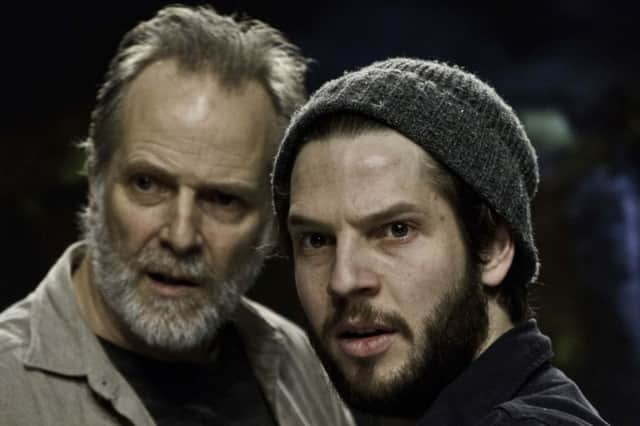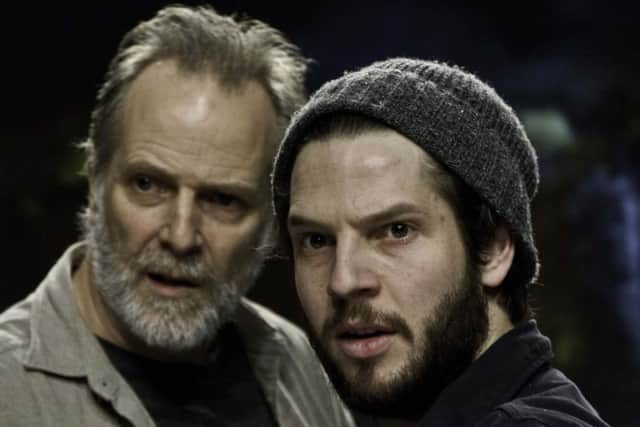The Body Of An American (review). A harrowing snapshot of war.


It’s no wonder some of them turn out crazier than a box of frogs.
Writer Dan O’Brien, himself no stranger to emotional trauma, spent nearly 20 years corresponding via email with battle-scarred Pulitzer-prize winning snapper Paul Watson and the outcome is The Body Of An American, one of the most exciting and original new plays that you’re ever likely to see.
Advertisement
Hide AdAdvertisement
Hide AdIts European premiere took place at the Royal & Derngate on Friday and I’m still reeling from the experience.


Director James Dacre, the Northampton venue’s new spiritual leader, has courageously brought the edginess and unconventionality of fringe theatre to a mainstream venue.
Right from the outset you know it’s going to be an unusual performance piece – and not for anyone who suffers from claustrophobia.
The two-hander, which stars former Silent Witness lead William Gaminara and Ripper Street’s Damien Molony, takes place in a contained coffin-shaped set, just one entrance, with two rows of seats along either side and fake snow on the ground.
Advertisement
Hide AdAdvertisement
Hide AdThere’s no way out once the 90-minute play starts. You’re trapped with the actors prowling up and down, like a pair of caged animals, just inches from where you sit. Their emotions are visceral - intense, provocative and intimate. Their only props are a couple of chairs which, at times, are swung wildly around. So close.
It’s very disconcerting when either Gamninara, as an emotionally unstable Watson or Molony’s fragile O’Brien, looks you right in the eye to deliver their next line. You feel partied to the scene. I almost felt that I wanted to reply with my own dialogue.
At either end images are flashed up. Some are regular Sunday Pictorial specials of children playing among war-torn ruins or of icy Alaskan vistas.
But there’s one which started off the men’s unusual relationship. It’s the body of an American pilot, dragged from a downed Black Hawk chopper and paraded through the streets to be violated by an angry mob.
Advertisement
Hide AdAdvertisement
Hide AdThe dead man’s hands are tied, most of his clothes ripped off and he’s being abused and spat upon. It’s an image of war, similar to thousands of others taken by Watson.
But it affected a young American writer, plagued with his own demons, who, until then, was struggling to come up with a piece about “historical ghosts”. He gets in touch.
The resulting play is over-analytical, in that way that Americans have of dissecting every emotion, but, equally, fascinating and immensely powerful.
We’ve never had the same respect, in this country, for war photographers. Who could name a famous British lensman?
Advertisement
Hide AdAdvertisement
Hide AdBut they have always been a big part of American journalism perhaps because the country always seems to be involved in turmoil somewhere in the world.
It’s difficult for Brits to understand the importance and necessity of their work when images from war zones are flashed into people’s homes via TV, social media and the digital age. Every soldier carries a smart phone. Who needs a guy risking his life to capture the human face of conflicts?
Even Watson’s own efforts go largely unrewarded. He may have been given a Pulitzer but, he admits, during the play, that only about six people bought his last book.
So it’s worth seeing as an experimental, curiosity piece. All the dialogue you hear comes from actual conversations between the two men.
Advertisement
Hide AdAdvertisement
Hide AdI’m not sure it travels well – it is peculiarly American – but the astonishing performances of both actors have a profound effect.
The speech comes machine-gun fast as they talk to each other, and to the audience, about their work and relationship. We are taken to a variety of locations around the globe, and over several years, as the emails fly from one to another, so you have to tune in and keep up with the pace.
Molony’s Dan is your typical scruffy, bearded, academic, long greasy hair stuffed into a beanie, carelessly dressed, trying to teach, write and come to terms with his own nightmares. He looks strained. It’s a very powerful performance from the rising TV star of Being Human and Suspects.
Gaminara’s impressive Canadian accent, last heard at Aylesbury’s Waterside Theatre in Less Than Kind, is rolled out, though at times drifts south of the border. As Watson he is way off the register and reminded me of Dennis Hopper’s crazed photojournalist in Apocalypse Now.
Advertisement
Hide AdAdvertisement
Hide AdI’m not so sure I believed O’Brien’s interpretation of the man. This Watson appears haunted by the ghosts of some of his subjects, particularly the dead American. Most snappers I know view the camera like an invisible shield to ensure they keep their distance from whatever they’re taking.
At the end of the day, they tell themselves, it’s just a picture. No emotional involvement. Stay detached and you can do the job.
The Body Of An American runs until Saturday. For tickets call the box office 01604 624811 or visit www.royalandderngate.co.uk